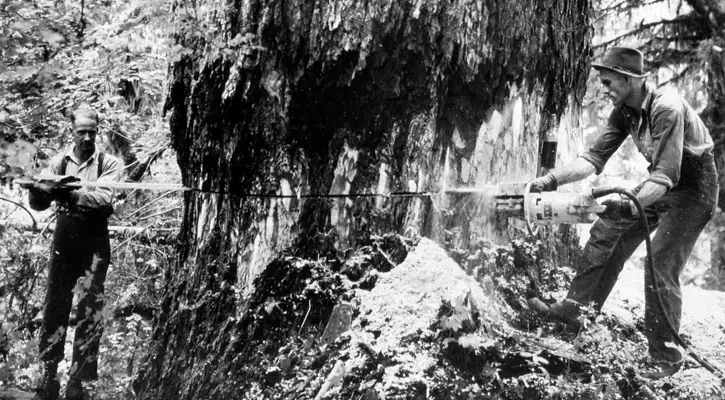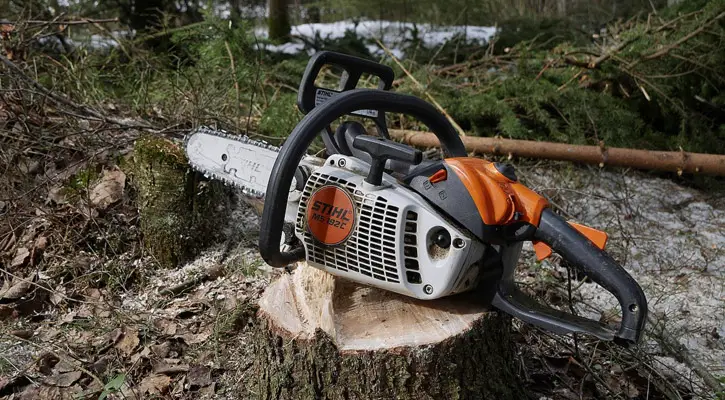Table of Contents
In 1830, the first type of chainsaw was invented, called the “osteotome”, and it was used in medical procedures.
In the 1920s, several companies began manufacturing chainsaws to be used in professional forestry work.
Today, we have the modern chainsaw that any homeowner can purchase and use to perform woodcutting tasks.
Now, if you want the full history and details about when were chainsaws invented, keep reading.

1830 — The First Chainsaw Was Invented
According to the Canadian Medical Association Journal, Bernhard Heine, a German physician and bone specialist, invented a medical tool called the “osteotome” around the year 1830.
The osteotome was a revolutionary new surgical tool for cutting bones.
It was a handheld device that included a long blade that guided a chain with sharp teeth around it through the turning of a handle connected to a sprocket wheel.
The osteotome made it much easier to cut through bone as compared to a hammer and chisel where splintering could occur.
With the invention of the osteotome, surgeons could perform craniotomies with smooth-edged holes, and cut in topographies that didn’t allow access with a circular saw.
The osteotome was technically the first chainsaw ever invented although it wasn’t used for cutting wood.
1861 to 1918
In 1861, the Hamilton Saw was invented, which was a hand-cranked chainsaw used by two men that looked like a giant spinning wheel.
In the 1880s, the American Riding Saw made its debut and was another human-powered chainsaw. This type, however, looked like a rowing machine that a single person sat on and would operate it.
Some reports claim that around the turn of the twentieth century, an inventor and naturalist named John Muir was the first person to transfer the idea of the osteotome to a larger mechanical machine that was used for logging purposes.
However, Muir’s invention of the logging chainsaw weighed hundreds of pounds and required a crane for operation, which led to little commercial success.
The earliest patent on record for an “endless chain saw” that had chain teeth that ran around a guide frame was granted to Samuel J. Bens on January 17, 1905.
The first portable chainsaw was patented in 1918 by Canadian James Shand. However, it was quite bulky and impractical to use so it wasn’t a huge success.

The 1920s — Mobile Chainsaws Are Manufactured
In 1926, German mechanical engineer, Andreas Stihl patented the first electric chainsaw to be used for logging purposes.
Three years later, in 1929, Stihl developed a gas-powered chainsaw version; however, Emil Lerp, founder of Dolmar chainsaw company, had already begun manufacturing gas-powered chainsaws in 1927.
Although Stihl and Dolmar both created chainsaws around the same time, Andreas Stihl is credited as the person who invented the mobile and motorized chainsaw.
It wasn’t until after World War II that improvements in aluminum and engine design were made that lightened chainsaws enough to where one person could carry them.
In 1950, the first one-man chainsaw was put into production but it was still quite heavy (around 30 lbs. or more).
In 1964, the first antivibration system was added to a chainsaw to make it easier to hold for longer periods of time.
In 1972, the manual chain brake bar was added to Stihl chainsaws to stop the chain from spinning when the bar was pressed during kickback.
In 1974, low profile chains were developed by Oregon to reduce the chances of kickback.
In 1977, Oregon released chainsaw blades that had a thinner tip. Nicknamed “banana bars”, this asymmetrical shape with a smaller bar-nose was highly effective in reducing kickback occurrences.
In 1982, the automatic chain brake was developed to stop the chain from spinning as soon as a sudden backward force was experienced in the blade.
In 1991, the automatic starting function was added to the chainsaw to replace the pull cord.

Chainsaws are an Ongoing Invention
While chainsaws have come on a long way since their inception in the 1800s, these machines are still rapidly developing.
Today, we extremely portable and lightweight chainsaws that operate with gasoline, electricity, and batteries. You can also choose a number of guide bar lengths from 6 inches to 72 inches and anywhere in between.
Clearly, we can only wonder what the future of chainsaws will look like, but you now have a complete history and answer to the question, “When were chainsaws invented?”
If you want to see a list of the top chainsaws you can buy today, check out my best chainsaw reviews page. It highlights every type of chainsaw and a variety of lengths.
If you’re interested in cutting firewood with a chainsaw, my other page on the best chainsaw for firewood can help you find the perfect tool for the task.
And finally, if you want a universal chainsaw for all types of tree cutting needs, check out my best all around chainsaw page. It shows you what to look for in a multi-purpose tool that can tackle any number of jobs for a low cost.
I hope you enjoyed this history lesson on the invention of chainsaws.
Happy sawing!

Your pal,
Chainsaw Larry

